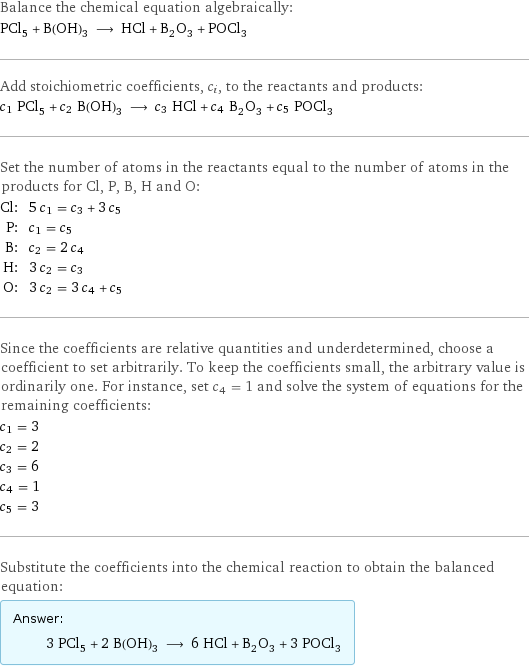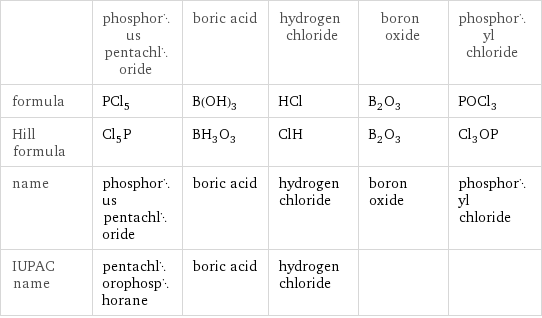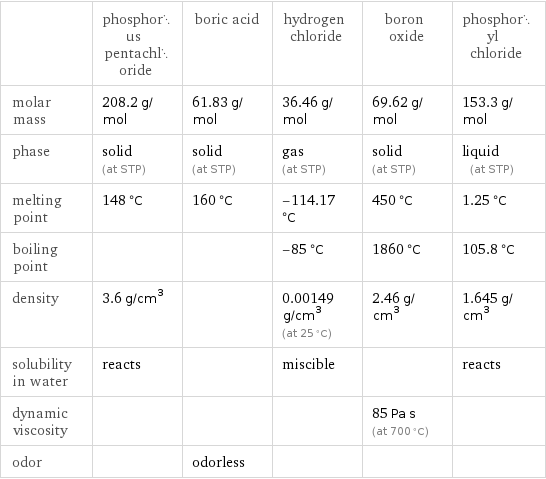Input interpretation

PCl_5 phosphorus pentachloride + B(OH)_3 boric acid ⟶ HCl hydrogen chloride + B_2O_3 boron oxide + POCl_3 phosphoryl chloride
Balanced equation

Balance the chemical equation algebraically: PCl_5 + B(OH)_3 ⟶ HCl + B_2O_3 + POCl_3 Add stoichiometric coefficients, c_i, to the reactants and products: c_1 PCl_5 + c_2 B(OH)_3 ⟶ c_3 HCl + c_4 B_2O_3 + c_5 POCl_3 Set the number of atoms in the reactants equal to the number of atoms in the products for Cl, P, B, H and O: Cl: | 5 c_1 = c_3 + 3 c_5 P: | c_1 = c_5 B: | c_2 = 2 c_4 H: | 3 c_2 = c_3 O: | 3 c_2 = 3 c_4 + c_5 Since the coefficients are relative quantities and underdetermined, choose a coefficient to set arbitrarily. To keep the coefficients small, the arbitrary value is ordinarily one. For instance, set c_4 = 1 and solve the system of equations for the remaining coefficients: c_1 = 3 c_2 = 2 c_3 = 6 c_4 = 1 c_5 = 3 Substitute the coefficients into the chemical reaction to obtain the balanced equation: Answer: | | 3 PCl_5 + 2 B(OH)_3 ⟶ 6 HCl + B_2O_3 + 3 POCl_3
Structures

+ ⟶ + +
Names

phosphorus pentachloride + boric acid ⟶ hydrogen chloride + boron oxide + phosphoryl chloride
Equilibrium constant
![Construct the equilibrium constant, K, expression for: PCl_5 + B(OH)_3 ⟶ HCl + B_2O_3 + POCl_3 Plan: • Balance the chemical equation. • Determine the stoichiometric numbers. • Assemble the activity expression for each chemical species. • Use the activity expressions to build the equilibrium constant expression. Write the balanced chemical equation: 3 PCl_5 + 2 B(OH)_3 ⟶ 6 HCl + B_2O_3 + 3 POCl_3 Assign stoichiometric numbers, ν_i, using the stoichiometric coefficients, c_i, from the balanced chemical equation in the following manner: ν_i = -c_i for reactants and ν_i = c_i for products: chemical species | c_i | ν_i PCl_5 | 3 | -3 B(OH)_3 | 2 | -2 HCl | 6 | 6 B_2O_3 | 1 | 1 POCl_3 | 3 | 3 Assemble the activity expressions accounting for the state of matter and ν_i: chemical species | c_i | ν_i | activity expression PCl_5 | 3 | -3 | ([PCl5])^(-3) B(OH)_3 | 2 | -2 | ([B(OH)3])^(-2) HCl | 6 | 6 | ([HCl])^6 B_2O_3 | 1 | 1 | [B2O3] POCl_3 | 3 | 3 | ([POCl3])^3 The equilibrium constant symbol in the concentration basis is: K_c Mulitply the activity expressions to arrive at the K_c expression: Answer: | | K_c = ([PCl5])^(-3) ([B(OH)3])^(-2) ([HCl])^6 [B2O3] ([POCl3])^3 = (([HCl])^6 [B2O3] ([POCl3])^3)/(([PCl5])^3 ([B(OH)3])^2)](../image_source/4cbf6e47dfce02e6491d88adf0a72b13.png)
Construct the equilibrium constant, K, expression for: PCl_5 + B(OH)_3 ⟶ HCl + B_2O_3 + POCl_3 Plan: • Balance the chemical equation. • Determine the stoichiometric numbers. • Assemble the activity expression for each chemical species. • Use the activity expressions to build the equilibrium constant expression. Write the balanced chemical equation: 3 PCl_5 + 2 B(OH)_3 ⟶ 6 HCl + B_2O_3 + 3 POCl_3 Assign stoichiometric numbers, ν_i, using the stoichiometric coefficients, c_i, from the balanced chemical equation in the following manner: ν_i = -c_i for reactants and ν_i = c_i for products: chemical species | c_i | ν_i PCl_5 | 3 | -3 B(OH)_3 | 2 | -2 HCl | 6 | 6 B_2O_3 | 1 | 1 POCl_3 | 3 | 3 Assemble the activity expressions accounting for the state of matter and ν_i: chemical species | c_i | ν_i | activity expression PCl_5 | 3 | -3 | ([PCl5])^(-3) B(OH)_3 | 2 | -2 | ([B(OH)3])^(-2) HCl | 6 | 6 | ([HCl])^6 B_2O_3 | 1 | 1 | [B2O3] POCl_3 | 3 | 3 | ([POCl3])^3 The equilibrium constant symbol in the concentration basis is: K_c Mulitply the activity expressions to arrive at the K_c expression: Answer: | | K_c = ([PCl5])^(-3) ([B(OH)3])^(-2) ([HCl])^6 [B2O3] ([POCl3])^3 = (([HCl])^6 [B2O3] ([POCl3])^3)/(([PCl5])^3 ([B(OH)3])^2)
Rate of reaction
![Construct the rate of reaction expression for: PCl_5 + B(OH)_3 ⟶ HCl + B_2O_3 + POCl_3 Plan: • Balance the chemical equation. • Determine the stoichiometric numbers. • Assemble the rate term for each chemical species. • Write the rate of reaction expression. Write the balanced chemical equation: 3 PCl_5 + 2 B(OH)_3 ⟶ 6 HCl + B_2O_3 + 3 POCl_3 Assign stoichiometric numbers, ν_i, using the stoichiometric coefficients, c_i, from the balanced chemical equation in the following manner: ν_i = -c_i for reactants and ν_i = c_i for products: chemical species | c_i | ν_i PCl_5 | 3 | -3 B(OH)_3 | 2 | -2 HCl | 6 | 6 B_2O_3 | 1 | 1 POCl_3 | 3 | 3 The rate term for each chemical species, B_i, is 1/ν_i(Δ[B_i])/(Δt) where [B_i] is the amount concentration and t is time: chemical species | c_i | ν_i | rate term PCl_5 | 3 | -3 | -1/3 (Δ[PCl5])/(Δt) B(OH)_3 | 2 | -2 | -1/2 (Δ[B(OH)3])/(Δt) HCl | 6 | 6 | 1/6 (Δ[HCl])/(Δt) B_2O_3 | 1 | 1 | (Δ[B2O3])/(Δt) POCl_3 | 3 | 3 | 1/3 (Δ[POCl3])/(Δt) (for infinitesimal rate of change, replace Δ with d) Set the rate terms equal to each other to arrive at the rate expression: Answer: | | rate = -1/3 (Δ[PCl5])/(Δt) = -1/2 (Δ[B(OH)3])/(Δt) = 1/6 (Δ[HCl])/(Δt) = (Δ[B2O3])/(Δt) = 1/3 (Δ[POCl3])/(Δt) (assuming constant volume and no accumulation of intermediates or side products)](../image_source/d8e471a6a4c6ec859ad0b2aadca893f0.png)
Construct the rate of reaction expression for: PCl_5 + B(OH)_3 ⟶ HCl + B_2O_3 + POCl_3 Plan: • Balance the chemical equation. • Determine the stoichiometric numbers. • Assemble the rate term for each chemical species. • Write the rate of reaction expression. Write the balanced chemical equation: 3 PCl_5 + 2 B(OH)_3 ⟶ 6 HCl + B_2O_3 + 3 POCl_3 Assign stoichiometric numbers, ν_i, using the stoichiometric coefficients, c_i, from the balanced chemical equation in the following manner: ν_i = -c_i for reactants and ν_i = c_i for products: chemical species | c_i | ν_i PCl_5 | 3 | -3 B(OH)_3 | 2 | -2 HCl | 6 | 6 B_2O_3 | 1 | 1 POCl_3 | 3 | 3 The rate term for each chemical species, B_i, is 1/ν_i(Δ[B_i])/(Δt) where [B_i] is the amount concentration and t is time: chemical species | c_i | ν_i | rate term PCl_5 | 3 | -3 | -1/3 (Δ[PCl5])/(Δt) B(OH)_3 | 2 | -2 | -1/2 (Δ[B(OH)3])/(Δt) HCl | 6 | 6 | 1/6 (Δ[HCl])/(Δt) B_2O_3 | 1 | 1 | (Δ[B2O3])/(Δt) POCl_3 | 3 | 3 | 1/3 (Δ[POCl3])/(Δt) (for infinitesimal rate of change, replace Δ with d) Set the rate terms equal to each other to arrive at the rate expression: Answer: | | rate = -1/3 (Δ[PCl5])/(Δt) = -1/2 (Δ[B(OH)3])/(Δt) = 1/6 (Δ[HCl])/(Δt) = (Δ[B2O3])/(Δt) = 1/3 (Δ[POCl3])/(Δt) (assuming constant volume and no accumulation of intermediates or side products)
Chemical names and formulas

| phosphorus pentachloride | boric acid | hydrogen chloride | boron oxide | phosphoryl chloride formula | PCl_5 | B(OH)_3 | HCl | B_2O_3 | POCl_3 Hill formula | Cl_5P | BH_3O_3 | ClH | B_2O_3 | Cl_3OP name | phosphorus pentachloride | boric acid | hydrogen chloride | boron oxide | phosphoryl chloride IUPAC name | pentachlorophosphorane | boric acid | hydrogen chloride | |
Substance properties

| phosphorus pentachloride | boric acid | hydrogen chloride | boron oxide | phosphoryl chloride molar mass | 208.2 g/mol | 61.83 g/mol | 36.46 g/mol | 69.62 g/mol | 153.3 g/mol phase | solid (at STP) | solid (at STP) | gas (at STP) | solid (at STP) | liquid (at STP) melting point | 148 °C | 160 °C | -114.17 °C | 450 °C | 1.25 °C boiling point | | | -85 °C | 1860 °C | 105.8 °C density | 3.6 g/cm^3 | | 0.00149 g/cm^3 (at 25 °C) | 2.46 g/cm^3 | 1.645 g/cm^3 solubility in water | reacts | | miscible | | reacts dynamic viscosity | | | | 85 Pa s (at 700 °C) | odor | | odorless | | |
Units
